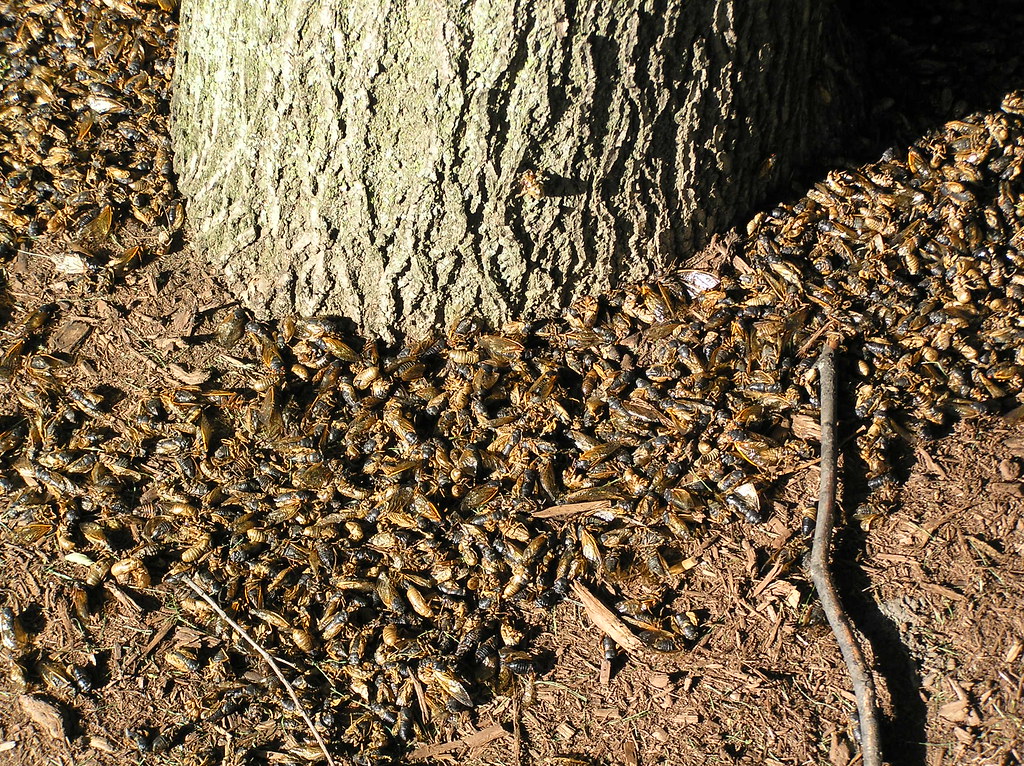Imagine walking through a forest when suddenly the air fills with a deafening roar that sounds like nature’s own alien invasion. Your ears ring, your heart pounds, and for a moment you wonder if you’ve stumbled into a science fiction movie. This isn’t Hollywood magic – it’s the real-world spectacle of cicadas emerging in their billions, orchestrating one of nature’s most brilliant survival strategies that has mystified scientists and captivated observers for centuries.
The Underground Army Prepares for Battle
Deep beneath the forest floor, an army has been waiting in silence for years, sometimes even decades. These aren’t soldiers with weapons, but cicada nymphs armed with nothing but time and an evolutionary strategy so cunning it would make military tacticians jealous. They’ve been feeding on tree roots, growing slowly, and synchronizing their internal clocks with a precision that rivals the most sophisticated timepieces.
The timing isn’t random – it’s calculated survival. Different species emerge on 13 or 17-year cycles, prime numbers that make it nearly impossible for predators to evolve synchronized life cycles to exploit them. This mathematical genius built into their DNA represents millions of years of evolutionary refinement.
Breaking Through the Earth in Synchronized Chaos
When the soil temperature hits exactly the right degree, something magical happens. Millions upon millions of cicadas begin their synchronized emergence, breaking through the earth like nature’s own zombie apocalypse. But unlike movie monsters, these creatures have a peaceful mission – to overwhelm their enemies not with violence, but with sheer numbers.
The emergence happens over just a few days, creating what scientists call “predator satiation.” It’s like trying to eat an entire buffet in one sitting – impossible, even for the hungriest bird or bat. This coordinated timing transforms individual vulnerability into collective invincibility.
The Decibel Defense System
As if their numbers weren’t intimidating enough, cicadas deploy their secret acoustic weapon. The collective chorus can reach 120 decibels – louder than a chainsaw, rivaling the noise of a rock concert. This wall of sound serves multiple purposes beyond just attracting mates.
The cacophony creates confusion among predators, making it difficult for them to focus on individual targets. Birds that hunt by sound find themselves overwhelmed by the audio chaos, like trying to have a conversation at a heavy metal concert. Some predators simply give up and seek quieter hunting grounds.
Strength in Numbers Strategy

Picture a single zebra facing a lion versus an entire herd thundering across the savanna. The principle is the same with cicadas, but multiplied by millions. When billions of insects emerge simultaneously, even the most efficient predators can only consume a tiny fraction of the population.
This strategy, known as “predator swamping,” ensures that no matter how many cicadas get eaten, the vast majority survive long enough to mate and lay eggs. It’s nature’s way of playing the odds, and the house always wins when you’re betting with billions.
Chemical Warfare Through Confusion

Cicadas don’t just rely on numbers and noise – they also deploy chemical confusion tactics. When threatened, they can release compounds that interfere with predator navigation and hunting abilities. These chemical signals can disrupt the normal hunting patterns of insects, spiders, and even some birds.
The sheer biomass of cicadas also changes the chemical landscape of the forest. Their presence alters the scent profiles that many predators rely on for hunting, essentially creating a chemical smokescreen that provides additional protection for the swarm.
The Flash Mob Effect
Ever seen a flash mob suddenly appear in a public square, creating instant chaos and confusion? Cicadas perfected this strategy millions of years before humans invented the concept. Their sudden, overwhelming appearance creates what researchers call “neophobia” – the fear of new or unfamiliar situations that causes many predators to hesitate or retreat.
Many animals have evolved to be cautious around sudden changes in their environment. When faced with an unprecedented explosion of potential prey, predators often exhibit stress behaviors and reduced hunting efficiency, giving cicadas precious time to establish themselves and begin mating.
Sacrificial Lamb Tactics
In any mass emergence, some cicadas will inevitably become meals for hungry predators. But here’s the genius part – these casualties aren’t random victims, they’re often the weaker or less fit individuals who serve as unwitting decoys. While predators focus on the easier targets, the stronger cicadas have more time and opportunity to mate successfully.
This brutal but effective strategy ensures that the genes of the fittest cicadas continue into the next generation. Nature doesn’t play favorites, but it does reward the clever and the prepared with survival advantages.
Overwhelming the Food Chain

When billions of cicadas emerge simultaneously, they essentially break the local food web. Predators that normally maintain balanced diets suddenly find themselves in an all-you-can-eat cicada buffet. But just like humans at a buffet, they can only consume so much before reaching their limit.
Birds, spiders, and other predators become so focused on the easy cicada meals that they temporarily ignore their other prey species. This creates unexpected benefits for other insects and small animals who experience reduced predation pressure during cicada emergence events.
The Speed Dating Phenomenon

Once the initial chaos subsides and predators become saturated, cicadas shift into high-speed reproduction mode. Males begin their complex mating songs, creating a competitive acoustic environment where only the strongest singers attract females. This urgency is crucial because cicadas have only a few weeks to complete their entire adult life cycle.
The mass distraction strategy buys them this precious time window. While predators are still recovering from the initial overwhelming emergence, cicadas can focus on their primary mission – ensuring the survival of their species for another 13 or 17 years.
Evolutionary Arms Race
Predators haven’t remained idle in this evolutionary game of hide and seek. Some birds have learned to time their breeding seasons to coincide with cicada emergences, taking advantage of the protein-rich bounty to feed their young. Certain spider species have evolved to build larger webs during emergence years.
However, cicadas maintain their advantage through the unpredictability of their prime-number cycles and the sheer scale of their emergences. Even the most adapted predators can’t evolve fast enough to keep pace with cicada strategies that have been refined over millions of years.
Geographic Coordination Mysteries

Scientists are still puzzled by how cicadas coordinate their emergences across vast geographic areas without any apparent communication system. Populations separated by hundreds of miles emerge within days of each other, suggesting some form of environmental cueing that researchers are only beginning to understand.
This coordination is critical to the mass distraction strategy’s success. If different populations emerged at different times, predators could simply move from area to area, maintaining high predation pressure. The synchronized emergence across entire regions ensures maximum effectiveness of the overwhelming numbers approach.
Climate Change and Future Challenges
As global temperatures shift and weather patterns become less predictable, cicadas face new challenges in maintaining their precisely timed emergence strategies. Some populations are beginning to emerge earlier than expected, potentially disrupting the synchronization that makes their mass distraction tactics so effective.
Climate change also affects predator populations and behaviors, creating uncertainty about whether traditional cicada strategies will remain effective. Some researchers worry that these changes could break the delicate balance that has allowed cicadas to thrive for millions of years.
Lessons from Nature’s Master Strategists

Human military strategists and business leaders have studied cicada emergence patterns for insights into coordination, timing, and overwhelming opposition through sheer scale. The principles of mass distraction have applications beyond entomology, from crowd control to market disruption strategies.
The cicada approach teaches us that sometimes the best defense isn’t fighting harder, but fighting smarter. By understanding when to act collectively and how to leverage natural advantages, even the most vulnerable individuals can achieve remarkable success against seemingly insurmountable odds.
The Next Great Emergence

Every spring, entomologists and nature enthusiasts await news of the next great cicada emergence. These events have become ecological celebrations, drawing researchers, photographers, and curious observers from around the world. The predictable unpredictability of cicada emergences creates a sense of anticipation that spans decades.
As climate change and human development continue to alter natural environments, each emergence becomes more precious and scientifically valuable. These mass distraction spectacles remind us of the incredible complexity and ingenuity present in nature’s survival strategies, strategies that have been tested and refined across geological time scales.
The next time you hear the thunderous chorus of cicadas filling the air, remember that you’re witnessing one of evolution’s most sophisticated survival strategies in action. These seemingly simple insects have mastered the art of collective defense through overwhelming numbers, precise timing, and acoustic warfare that would impress any military commander. Their success story spanning millions of years proves that sometimes the most effective strategy isn’t to hide from your enemies, but to show up in such overwhelming force that resistance becomes futile. What other secrets might nature be hiding in plain sight, waiting for us to discover their brilliance?
